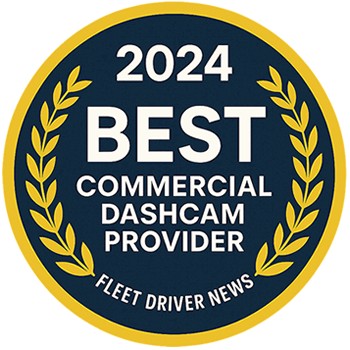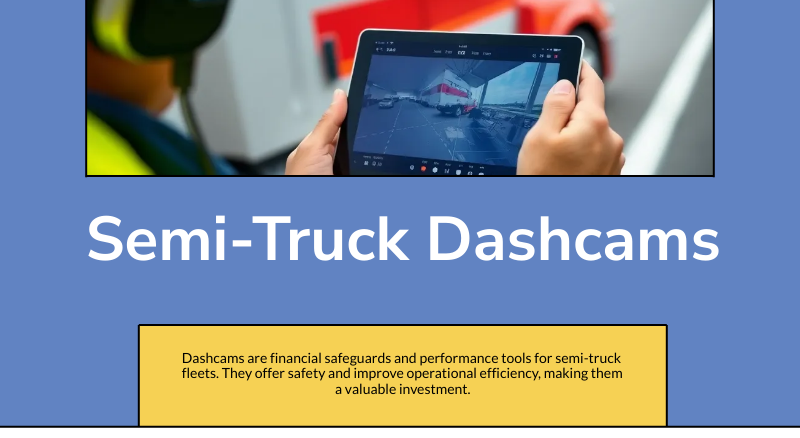
Best Dash Cam for Semi Trucks: Features, Benefits, and Buying Considerations
Why Semi Truck Fleets Are Investing in Dash Cams
For fleet managers and independent operators, the right dash cam isn’t just a piece of equipment — it’s a financial safeguard. With nuclear verdicts driving insurance settlements into the millions, trucking companies need verifiable video evidence to defend drivers and control claims costs.
But protection is only one side of the equation. Modern dash cams also deliver operational value: real-time GPS tracking, driver coaching, and cloud-based analytics that integrate directly with fleet management software. In other words, a dash cam for semi trucks is both a safety net and a performance tool — making it a high-ROI investment.
Key Features to Look For in a Semi Truck Dash Cam
When evaluating products, decision-makers should prioritize features that balance risk reduction, compliance, and operational efficiency. The following are non-negotiables for commercial use:
- Dual- or Multi-Camera Coverage: Road-facing, driver-facing, and optional side/rear views.
- AI-Powered Event Detection: Flags harsh braking, distracted driving, or fatigue.
- Cloud Storage & Live Streaming: Secure uploads and instant access when incidents occur.
- GPS & Telematics Integration: Syncs location, speed, and route data with fleet platforms.
- Durability & Compliance: Built for long-haul environments, often with FMCSA compliance in mind.
These features distinguish consumer dash cams from true commercial-grade solutions.
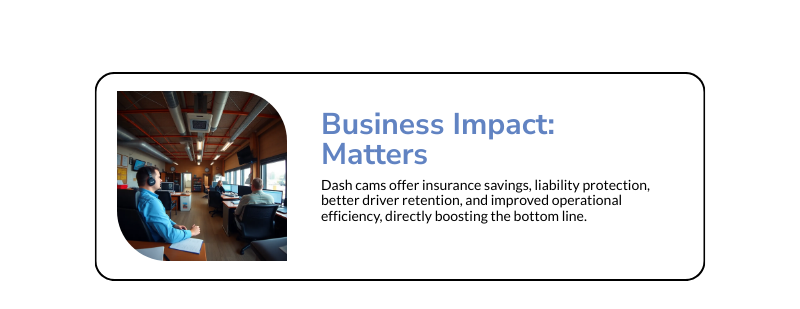
Business Impact: Why the Right Dash Cam Matters
- Insurance Savings: Fleets with dash cams often see insurance premiums reduced by 10–15%.
- Liability Protection: In accident disputes, video evidence is often the deciding factor.
- Driver Retention & Training: Footage helps coach drivers and build a culture of safety.
- Operational Efficiency: Integration with fleet systems allows better route planning and reduced downtime.
For executives weighing the investment, these are measurable outcomes that directly affect the bottom line.
Comparing Dash Cams for Semi Trucks
| Feature | Consumer Dash Cam | Commercial Truck Dash Cam |
| Video Quality | 1080p | 1080p–4K with night vision |
| Coverage | Road-facing only | Road, driver, side, rear |
| Event Detection | Limited | AI-powered, real-time alerts |
| Data Access | Local SD card | Cloud storage + live streaming |
| Fleet Integration | None | Full telematics integration |
| Durability | Moderate | Heavy-duty, vibration- & heat-resistant |
This comparison makes it clear why commercial buyers need to choose a system built for fleets rather than trying to repurpose consumer-grade hardware.
Pricing Considerations for Semi Truck Dash Cams
The cost of a dash cam for semi trucks can vary widely depending on whether you purchase a standalone unit or invest in a fleet-wide solution.
- Basic Models ($200–$400 per unit):
Suitable for independent operators or small fleets. Typically road-facing only, with local storage (SD cards). Limited features, but cost-effective. - Mid-Tier Options ($500–$800 per unit):
Often dual-facing, with GPS tracking and cloud upload capabilities. A balance between cost and capability, making these the most popular choice for fleets seeking both protection and oversight. - Premium Fleet Systems ($1,000+ per unit, plus monthly SaaS fees):
AI-enabled, with multi-camera configurations, real-time driver alerts, and full integration with telematics. These systems may involve subscription fees for cloud storage and analytics but deliver the strongest ROI through safety and compliance improvements.
Pro Tip: For larger fleets, the upfront cost should be evaluated against potential insurance discounts, reduced legal liability, and improved driver safety metrics. Many fleets report breaking even within the first year.
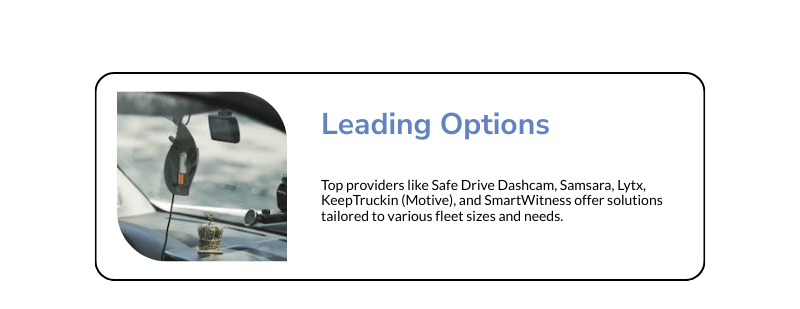
Leading Dash Cam Options for Semi Trucks
While there are many manufacturers, the top providers in the commercial space typically include:
- Safe Drive Dascham: Safe Drive Dashcam delivers AI-powered video protection and fleet tracking in one durable system — reducing accidents, cutting claims, and keeping your drivers and assets safe.
- Samsara: Known for AI-driven video safety and seamless integration with fleet management platforms.
- Lytx: A pioneer in the space, specializing in behavior-based driver coaching and accident reduction.
- KeepTruckin (Motive): Popular for its balance of affordability and cloud-based visibility.
- SmartWitness: Trusted for compliance-focused recording and modular camera options.
Each has its differentiators, and the best choice often comes down to the size of your fleet, your budget, and whether you need full telematics integration or a standalone safety solution.
ROI: How Dash Cams Pay for Themselves
Decision-makers often hesitate at the initial investment, but the return is clear when measured against potential risks and ongoing costs:
- Accident Defense: Just one recorded incident that protects your fleet from liability can cover the cost of an entire rollout.
- Lower Premiums: Many insurers now offer discounts for fleets with certified dash cam programs.
- Reduced Claims: Fleets using dash cams report up to a 50% reduction in claims frequency.
- Driver Productivity: Video coaching reduces violations and improves CSA scores, which directly impacts operating costs.
The ROI isn’t hypothetical — it’s measurable, and in most cases, immediate.
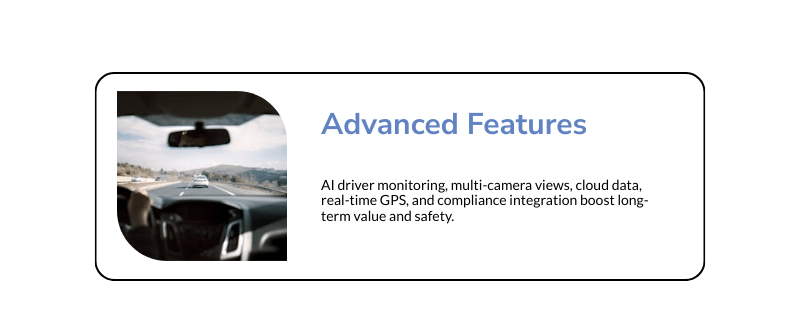
Advanced Features That Differentiate Semi Truck Dash Cams
Not all dash cams are created equal, and for a commercial buyer, the difference between an entry-level product and a premium fleet-grade system can be night and day. Here are some advanced features that help decision-makers identify which solutions offer real long-term value:
AI-Powered Driver Monitoring
Modern dash cams don’t just record events — they analyze them. AI-enabled systems can detect fatigue, distraction, seatbelt compliance, and even mobile phone usage. When flagged in real-time, these alerts give drivers a chance to self-correct before risky behavior leads to an incident.
Multi-Camera Configurations
For semi trucks pulling long trailers, a single road-facing camera may not provide enough coverage. Multi-camera solutions allow side and rear monitoring, eliminating blind spots and protecting against claims of unsafe lane changes or backing incidents.
Cloud-Based Data Management
With cloud connectivity, fleet managers can access video footage within minutes of an incident. This speed can be the difference between disputing a claim immediately or waiting weeks for legal proceedings. Cloud systems also simplify compliance reporting and reduce the burden of physical data storage.
Real-Time GPS and Telematics
Dash cams that double as telematics devices add another layer of efficiency. Fleet managers can monitor vehicle speed, optimize routes, and track fuel efficiency while using the same system for video safety. Consolidating tools reduces vendor complexity and lowers costs over time.
Compliance Integration
Some advanced providers build compliance tools directly into their platforms, helping fleets manage Hours of Service (HOS) logs, driver coaching sessions, and even FMCSA reporting. For regulated fleets, this level of integration is invaluable.
Common Objections to Buying Semi Truck Dash Cams — and How They’re Resolved
Even with clear benefits, many fleet executives and independent drivers hesitate. Here are the top concerns — and why they often don’t hold up under scrutiny.
- “The cost is too high.”
While upfront investment can feel steep, the ROI calculation almost always favors adoption. One nuclear verdict avoided, or one fraudulent claim dismissed, can offset the entire purchase price across an entire fleet. - “Drivers won’t want to be recorded.”
Many drivers initially resist, but when footage proves their innocence in a collision, attitudes often change quickly. Transparent communication and framing the system as a safety tool rather than a surveillance tool typically resolves this concern. - “The technology seems complicated.”
Leading providers offer turnkey setups with plug-and-play hardware and user-friendly dashboards. Ongoing support and training are also part of most commercial contracts. - “Won’t storing video be a nightmare?”
Cloud-based platforms eliminate the need for manual SD card swaps and provide unlimited, searchable storage. For fleet managers, this actually reduces workload rather than adding to it
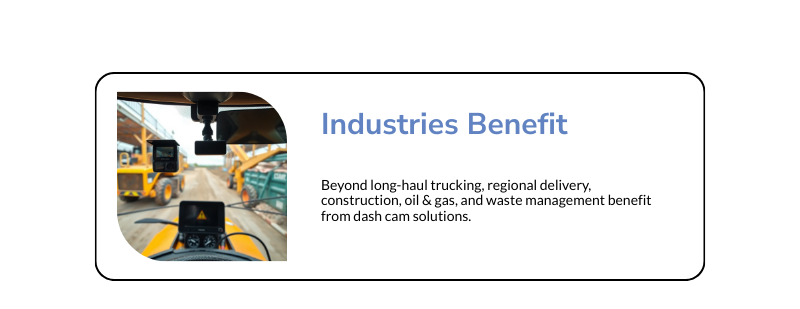
Industries Beyond Long-Haul Trucking That Benefit From Dash Cams
Although this piece focuses on semi trucks, the same commercial-grade solutions benefit other heavy-duty and fleet-intensive industries:
- Regional Delivery Fleets: Last-mile carriers can document package deliveries and defend against false claims of non-delivery.
- Construction and Heavy Equipment: Protects against liability on congested job sites while ensuring compliance with safety rules.
- Oil & Gas Transportation: Enhances driver monitoring in hazardous hauling conditions, reducing risk for high-value cargo.
- Waste Management: Multi-camera setups can capture side-load activity and confirm service stops.
The broader use cases highlight that investing in dash cams is part of a larger shift in transportation: visibility is no longer optional.
Extended FAQ: Dash Cams for Semi Trucks
What’s the difference between a consumer dash cam and a commercial-grade dash cam?
Consumer models are designed for short daily drives and personal use. They typically have one road-facing camera, limited durability, and local storage. Commercial-grade dash cams are engineered for heavy use, offer multiple angles, integrate with fleet management systems, and withstand extreme environments.
Can dash cams reduce my fleet’s insurance premiums?
Yes. Many insurers offer discounts for fleets that adopt verified dash cam programs. Discounts can range from 5–15%, depending on your insurer and whether the system includes AI-based driver monitoring.
Are dual-facing cameras worth it?
For commercial fleets, yes. Road-facing cameras protect against outside liability, while inward-facing cameras capture driver behavior, which is critical for coaching and liability protection. Together, they provide a full context of any incident.
Do dash cams comply with FMCSA regulations?
Dash cams are legal under FMCSA rules as long as they are mounted outside the driver’s direct line of sight. Some fleet solutions even support FMCSA recordkeeping and Hours of Service integration, making compliance easier.
How much data storage do I need?
With cloud storage, you won’t need to worry about physical capacity. Most systems allow for rolling video storage of 30, 60, or 90 days, with unlimited access to flagged event clips.
Do drivers need to consent to dash cams?
While consent laws vary by state, most fleets include dash cam policies in their driver contracts. Clear communication ensures drivers understand the purpose — protection, not surveillance.
Can dash cams detect drowsy or distracted driving?
Yes. AI-enabled dash cams can monitor driver eye movement, steering patterns, and head position to detect fatigue or distraction. Alerts are given in real-time, reducing accident risk.
What’s the typical lifespan of a dash cam system?
Commercial systems often last 3–5 years, depending on usage and environmental conditions. Premium providers may include extended warranties and hardware upgrades as part of service contracts.
Do dash cams work at night or in poor weather?
Most modern models include infrared night vision and wide dynamic range (WDR) technology, ensuring clear footage in low light, rain, or snow. This makes them especially valuable for long-haul drivers operating through varied conditions.
Can dash cams track location and speed?
Yes. Integrated GPS ensures every video clip is tagged with time, speed, and location data. This information is critical in accident disputes and can also improve routing efficiency.
What about installation? Is it complicated?
Many systems offer plug-and-play installation through the vehicle’s OBD-II port or 12V connection. More advanced setups may require professional installation, especially if multiple cameras are being used.
How do fleets handle privacy concerns?
Privacy is addressed by limiting data access to authorized managers, restricting how long non-incident footage is stored, and using footage strictly for safety, training, and compliance purposes.
Can footage be shared instantly after an accident?
Yes. Cloud-enabled systems upload critical event clips automatically. Fleet managers can access and share them within minutes, ensuring faster claims processing.
What’s the best dash cam brand for semi trucks?
It depends on your needs. Samsara and Lytx excel at AI safety solutions, Motive (KeepTruckin) balances affordability with features, and SmartWitness offers modular flexibility. The “best” choice comes down to your budget, fleet size, and integration requirements.
Making the Right Choice
For fleet operators, the decision to invest in a dash cam system is no longer just about peace of mind — it’s about financial protection, compliance, and operational efficiency. With advanced features like AI-based monitoring, multi-camera coverage, and telematics integration, the right dash cam for semi trucks can reduce liability, cut costs, and create a measurable competitive advantage.
In today’s environment, where one false claim can threaten the stability of an entire fleet, the question isn’t whether to adopt dash cams, but which system offers the greatest value for your specific business.

